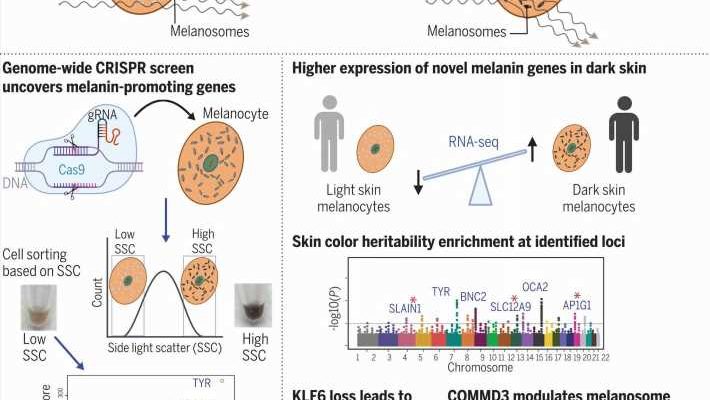
A team of geneticists and systems biologists at Stanford University has associated 169 genes that with the production of melanin in the skin, hair and eyes. In their study, reported in the journal Science, the group conducted a flow cytometry analysis and genome-wide CRISPR screen of cell samples.
Prior research has shown that the production and distribution of melanin in the body is responsible for skin tone, hair color and eye pigmentation. Such characteristics are important for more than appearance’s sake; skin with more melanin, for example, is better able to protect against ultraviolet radiation. In this new effort, the researchers noted that while many of the genes responsible for melanin production have been identified, many more have not.
The researchers began with an effort to differentiate high and low melanin melanocytes—the cells that make melanin. They used the light-reflecting properties of melanin to sort cells in a lab dish by aiming a fluorescent lamp at them. Once they had the cells sorted, they edited them using CRISPR-Cas9. Genes were systematically mutated to switch them off and then tested to see how well the cell continued to produce melanin.
The team found 169 genes that played a role in melanin production, of which 135 had not been previously identified. Next, they tested their results with human tissue recovered from donated infant foreskins. They found that almost 70% of the genes they had isolated were more active in infants with dark skin tones than in those with lighter skin tones.
The researchers note that not all the genes they isolated appear to be directly related to melanin production—some are involved in diverse biological functions. They further note that they were able to divide the gene group into two main types: those that assist in regulating genes and those that help with trafficking endosomes (transport packets). They also found that at least one of the genes they identified plays a role in the maturation of melanosomes and another is involved in regulating pH levels.
More information:
Vivek K. Bajpai et al, A genome-wide genetic screen uncovers determinants of human pigmentation, Science (2023). DOI: 10.1126/science.ade6289
Journal information:
Science
Source: Read Full Article
